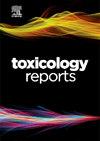低分子量壳聚糖降低丙烯酰胺对黑腹果蝇的毒性
Q1 Environmental Science
引用次数: 0
摘要
丙烯酰胺(ACR)是高温食品加工的有毒副产物,由于其氧化、神经毒性和基因毒性,对健康构成重大风险。监管措施的重点是限制商业食品中的ACR,但日常烹饪做法往往导致未被注意到的接触,威胁到儿童等弱势群体。本研究评价了低、中分子量壳聚糖(MW)对acr致黑腹果蝇的保护作用。壳聚糖是一种具有抗氧化和益生元特性的天然多糖,在ACR暴露的同时,在幼虫和成虫中添加壳聚糖。评估了诸如化蛹率、繁殖力和成虫羽化等发育指标,以及氧化应激标志物和神经行为结果。ACR暴露损害发育,增加氧化应激,减少运动活动。添加低、中分子量壳聚糖可减轻上述影响,其中低分子量壳聚糖效果更好。这些发现揭示了低分子量壳聚糖作为一种饮食干预的潜力,可以抵消ACR等污染物的毒性作用。壳聚糖通过减少氧化应激、保持线粒体功能和支持发育过程,为减轻热处理毒素的整体毒性提供了一条有希望的途径。这些发现进一步强调了壳聚糖对ACR毒性的分子量依赖性保护潜力,为其作为热处理毒素的膳食缓解剂的应用提供了见解。本文章由计算机程序翻译,如有差异,请以英文原文为准。
Low molecular weight chitosan attenuates acrylamide-induced toxicity in Drosophila melanogaster
Acrylamide (ACR), a toxic by-product of high-temperature food processing, poses significant health risks due to its oxidative, neurotoxic, and genotoxic properties. Regulatory measures focus on limiting ACR in commercial food products, yet daily cooking practices often result in unnoticed exposure, threatening vulnerable populations such as children. This study evaluates the protective role of low and medium molecular-weight (MW) chitosan against ACR-induced toxicity using Drosophila melanogaster. Chitosan, a natural polysaccharide with antioxidant and prebiotic properties, was supplemented alongside ACR exposure in larvae and adult flies. Developmental metrics such as pupation rates, fecundity, and adult emergence were assessed, alongside oxidative stress markers and neurobehavioral outcomes. ACR exposure impaired development, increased oxidative stress, and reduced locomotor activity. Supplementation with low and medium MW chitosan alleviated these effects, with low MW chitosan demonstrating greater efficacy. These findings reveal the potential of low MW chitosan as a dietary intervention to counteract the toxic effects of contaminants like ACR. By reducing oxidative stress, preserving mitochondrial function, and supporting developmental processes, chitosan offers a promising avenue for mitigating the overall toxicity of heat-processed toxins. These findings further highlight chitosan's molecular weight-dependent protective potential against ACR toxicity, offering insights into its application as a dietary mitigator of heat-processed toxins.
求助全文
通过发布文献求助,成功后即可免费获取论文全文。
去求助
来源期刊

Toxicology Reports
Environmental Science-Health, Toxicology and Mutagenesis
CiteScore
7.60
自引率
0.00%
发文量
228
审稿时长
11 weeks
 求助内容:
求助内容: 应助结果提醒方式:
应助结果提醒方式:


